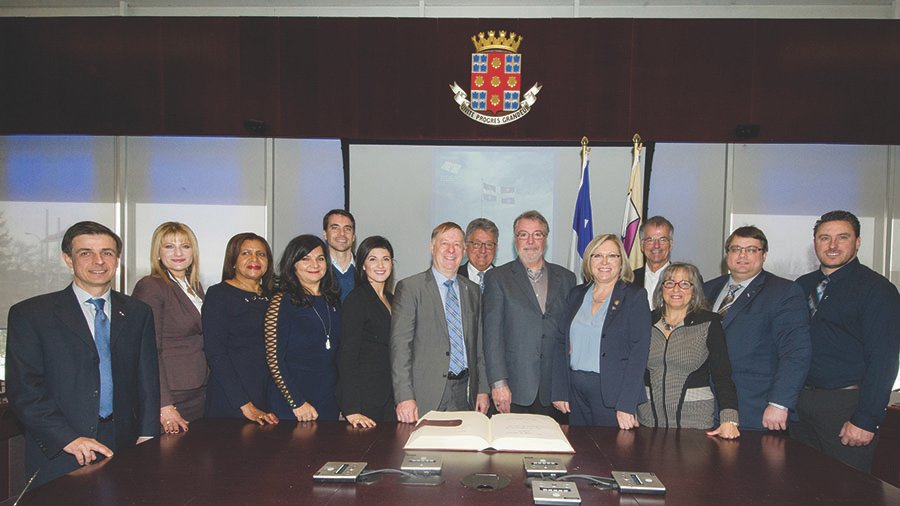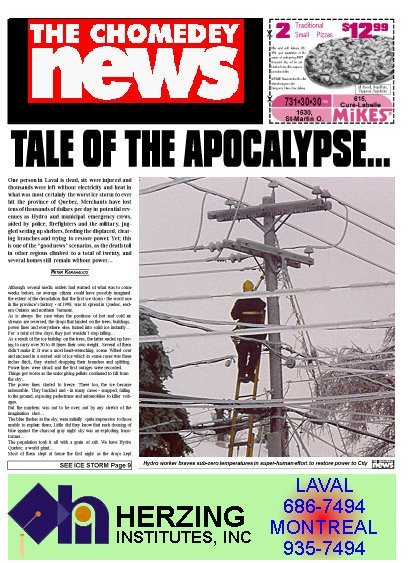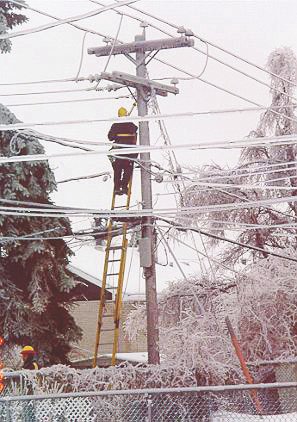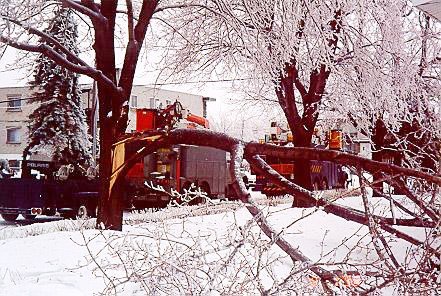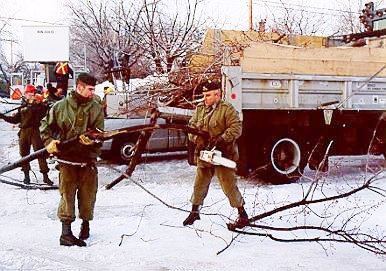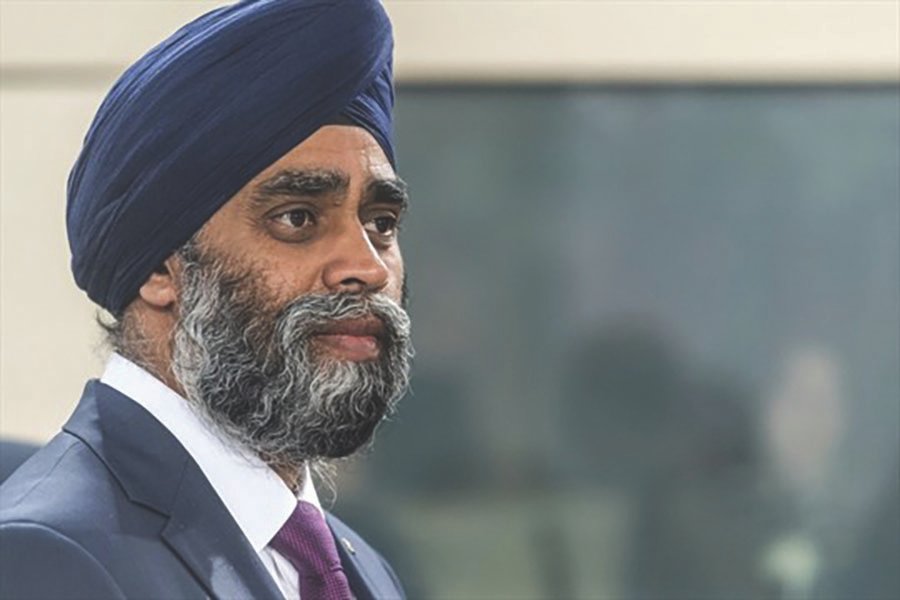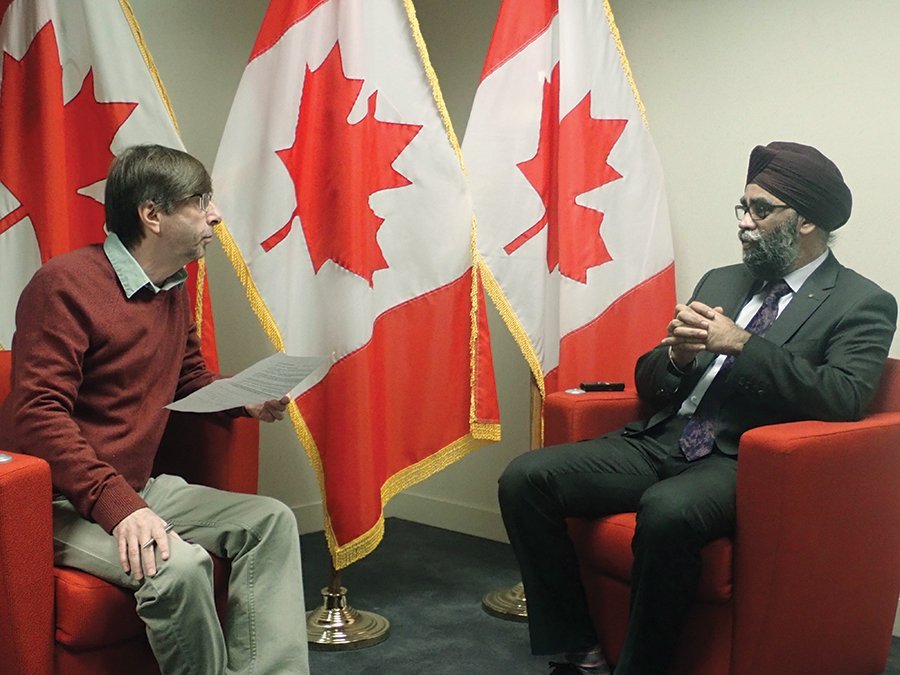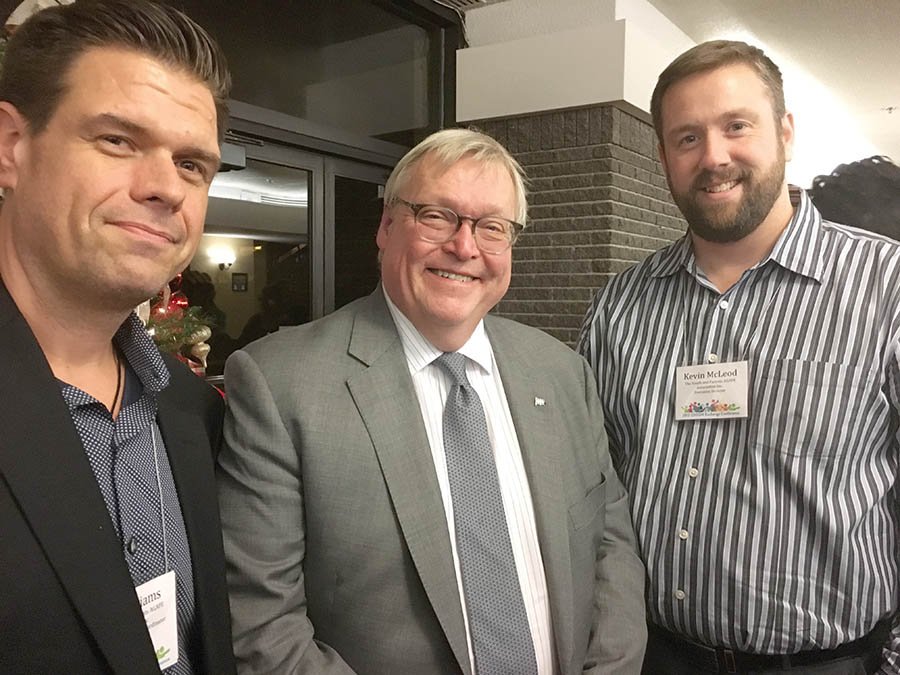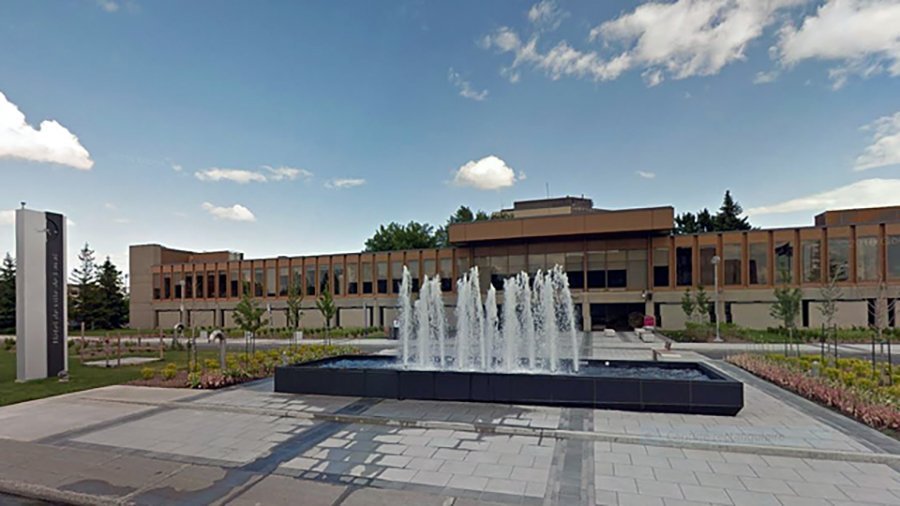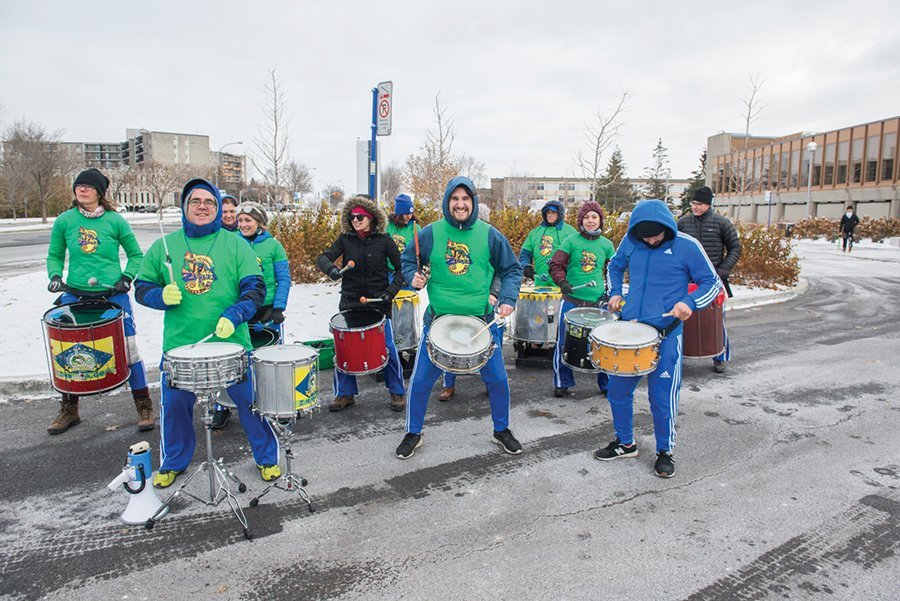Martin C. Barry
If 2017 in Laval started out tumultuously, with raucous protests outside city hall by police officers disrupting rather than ensuring the public’s well-being and safety, the year would end on a note of greater certainty, when municipal elections were over, but with preparations for provincial elections in 2018 already underway.
January
The first public meeting of Laval city council in 2017 on Jan. 17 was a noisy one. The Laval Police Brotherhood, the union representing the city’s police officers, staged a protest outside city hall, making it nearly impossible for anyone inside to hear anything going on during the meeting.
The protest concerned complaints from the police union that the city had been dragging its heels in hiring more staff officers since the current administration was swept into office in the 2013 election. André Potvin, president of the police brotherhood, got up to question Mayor Marc Demers during the council meeting.
The first month of 2017 also saw the City of Laval take some of the initial steps leading towards the planned construction of a new municipal aquatic complex. The city announced the winner of a competition held to produce a design for the future complex.
The NFOE-HCMA consortium was chosen for the building to be located on Terry Fox Ave. near the Cosmodôme. The corporation will be responsible for all planning and specifications for the building itself, as well as supervision of construction which is expected to be completed by 2020.
“This is the first time that the City of Laval held an architecture competition and I am delighted with the results,” said Mayor Marc Demers. “Citizens will be able to take advantage of a building of very high quality that will raise the value of Laval’s building heritage.”
Federal Minister of Families, Children and Social Development Jean-Yves Duclos and Quebec Minister of Municipal Affairs Martin Coiteux were at the Habitation Raymond-Goyer in Chomedey on Jan. 16 to announce more than $407 million in funding over two years for the creation of additional affordable and social housing across the province.
Laval for its part would receive $18.2 million to build 124 new units at the long-neglected Val-Martin social housing project. Nonetheless, the assistance still fell far short of providing for a 1,000-social housing unit goal. All the same, Mayor Marc Demers was visibly pleased with the commitment made by Quebec and Ottawa.
On Jan. 25, the Laval News’ “LPD Blue” police column reported the Laval Police were looking for potential victims of a trio of moneylenders who were practising extortion in the Laval region. When customers couldn’t repay loans at usurious interest rates, they would be pressured to commit criminal acts such as fraud or arson on behalf of the lender/extortionists.
While the month of January can be a dull and depressing time, a hopeful ray of light shone for the staff and clients at Agape in Chomedey when city councillor Vasilios Karidogiannis dropped by with a $450 donation to the charitable services group. Although it was the first time Karidogiannis, who represents the district of l’Abord-à-Plouffe, made a major donation to Agape, he said it’s something that would probably become an annual tradition.
February
The Rocket de Laval, the Montreal Canadiens’ AHL affiliate team starting in the 2017-2018 season, officially unveiled the new logo and uniforms the players would be wearing when they hit the ice at the new Place Bell. According to the Laval News’ Feb. 8 edition, Geoff Molson, Marc Bergevin and several former Canadiens players were on hand at Carrefour Laval for the unveiling on Jan. 31.
Also in the Feb. 8 edition was news that the Sir Wilfrid Laurier Foundation’s annual winter fundraising gala raised more than $47,000 for educational projects at schools and training centres operated by the Sir Wilfrid Laurier School Board. Held at the Embassy Plaza in Chomedey on the evening of Jan. 26, a highlight of the event was a set of performances by the Ultimate Showband.
Without a new contract with the City of Laval for the past few years, members of the Laval Police Brotherhood continued this month to step up their pressure tactics. The union listed among its grievances the claim that the police department was operating with a much lower number of patrol cars than should normally be the case for a city with a population of more than 420,000.
“There have been days when police haven’t been able to get out to patrol because there was a shortage of patrol cars,” Brotherhood president André Potvin said in an interview with the Laval News.
Ongoing poor snow removal in Laval prompted Laval News co-publisher George Guzmas to state in an editorial on Feb. 22 that readers were ringing the phones and sending in e-mails lately complaining about “non-existent or poor snow removal” in their neighbourhoods.
While presenting evidence that the Demers administration had indeed been steadily increasing the budget for snow removal over the years, there were no signs of better snow removal, Guzmas said. “It’s time for Lavallers to receive the services they pay and they deserve as taxpayers by all means,” he wrote.
What goes through parents’ minds when they first discover they have a child who is afflicted with autism? During a talk to the Laval Chamber of Commerce and Industry covered by the Laval News in February, retired U.S. pharmacy executive Randy Lewis successfully argued that businesses should think seriously about fostering diversity in the workplace by including employees with autism and other disabilities.
With an announcement that they had initiated the first steps towards opening a “Wellness Centre,” Chomedey-based Agape Youth and Parents Association decided the time had come to take a big leap forward to serve some of the forgotten needs of English-speaking senior citizens in Laval. The news was formally announced during a meeting of the Laval/Agape NPI Partners Committee at the Jewish Rehabilitation Hospital on Feb. 16.
March
During an afternoon luncheon held at the Château Royal on Sunday March 5 to mark International Women’s Day (March 8), more than 100 members of the Hellenic Women’s Federation of Laval-Electra heard from a Laval woman who made her mark in the world and who offered advice on how others can advance in their careers and lives.
The theme of this year’s meeting was ‘Be Bold for Change.’ The keynote speaker was Dr. Hellen Christodoulou, executive-director for Quebec of the Canadian Institute of Steel Construction and a renowned expert in the design and maintenance of bridges.
In a bid to support groups dedicated to improving the well-being and continuing development of Laval’s senior citizens, Quebec Minister for Senior Citizens Francine Charbonneau announced $318,000 in subsidies to four groups in Laval that provide assistance to seniors.
Charbonneau told the Laval News that her ministry wanted to make sure the organizations receiving the subsidies would have enough resources to do their work on behalf of the seniors. The four organizations receiving the sums under the provincial government’s Québec ami des aînés (QADA) program were DIRA-Laval ($82,180), La Société Alzheimer de Laval ($76,950), Groupe Promo-Santé ($66,350) and le Comité lavallois en abus et violence envers les aînés (CLAVA) ($77,756).
U.S. President Donald Trump seemed to be turning up just about everywhere a few months after he was elected, whether it was on Saturday Night Live – or on stage at Laval Senior Academy.
Trump’s mesmerizing influence was evident in LSA’s 2017 Blue & Gold Review, which they put together with the help of more than a half-dozen staffers who helped stage it at the Souvenir Blvd. school, with coverage in the Laval News’ March 8 issue.
The epic snow storm that swept through Laval and the Montreal region in mid-March impacted the lives of many people – including a UPS delivery driver who lives in Laval and who was among hundreds of motorists stranded on Autoroute 13.
George Typaldos told the Laval News he had just finished his route during the early evening of March 14 and was returning his vehicle to the UPS depot, when he got caught up in the massive traffic jam on the southbound A-13. He was stranded in his truck from 6:30 pm on March 14 to 7:30 am March 15.
One of the Laval region’s most historically important churches – Sainte-Rose-de-Lima on Sainte-Rose Boulevard – received more than $250,000 from the Quebec Liberal government to help maintain the structural and architectural well-being of the church building.
The current church building, which is more than 160 years old, dates from around 1856. Sainte-Rose-de-Lima was granted a special status as a protected heritage building in 1974. The funding for the restoration work was announced by Sainte-Rose Liberal MNA Jean Habel during a press event held at the church on March 13.
April
The Laval News’ April 5 edition reported Quebec Premier Philippe Couillard joining hundreds of members of the Quebec Liberal Party in a celebration at the Embassy Plaza to mark an historic moment in the PLQ’s history – the 150th anniversary of the party’s founding.
“In 150 years we’ve never hesitated to do things which were difficult,” Premier Couillard said in the event’s keynote speech. Couillard touched on several other issues, including the PLQ’s ability to strike a proper balance between social justice and economic growth.
The April 5 issue also reported elected officials from three levels of government gathering at the war cenotaph near Laval city hall in late March to pay their respects along with residents of Hellenic origin to Greek veterans and soldiers on the occasion of the 196th anniversary of Greece’s independence.
Speaking briefly in his office where a Golden Book signing ceremony took place, Mayor Marc Demers acknowledged the demographic significance in Montreal of Greeks, who number up to 62,000 residents in the region. “It’s important to preserve traditions and cultural heritage,” he said, while apologizing for being limited in his knowledge of the Greek language.
According to the April 5 LPD Blue police column, a decapitated goat was found by passers-by near the entrance to Parc-des-Prairies on 15th Ave. in Laval-des-Rapides recently. It was the second time in as many weeks that the police had been alerted by neighbours. City workers confirmed that animal remains were also found at other parks in the area.
For the third year since the creation of the Laval Ethics and Integrity Office (BIEL), Laval police chief Pierre Brochet tabled a report of efforts made over the last 12 months to keep track and stop acts of corruption from taking place within the city’s administration.
“We’re very proud with the results,” Brochet said in an interview with the Laval News, while adding that experience is making the task of compiling each year’s report easier. “We’re writing the book,” he said, noting that Laval Police is the only police department in Quebec mandated to carry out the task in this specific manner.
Officials from the City of Laval and from junior hockey groups in Sainte-Dorothée were on hand at the former Samson Arena on April 9 for two reasons: to mark the completion of renovations at the facility, and to honour retired NHL right-winger Martin Saint-Louis whose name is now spelled out on the outside wall of the arena.
For Saint-Louis, who retired last year from the New York Rangers, it was a homecoming since he got his start in hockey while playing at peewee and junior levels at the Samson Arena. Laval is Saint-Louis’s hometown.
A Laval-based manufacturer of industrial pallets which has developed a unique approach to the linguistic integration of newcomers earned the praise of Quebec Immigration Minister Kathleen Weil when she visited the company’s facilities on April 7.
“I’m seeing an extremely important endeavour,” Weil said about Standard Pallet Industries (IPS)’s efforts. IPS went beyond the normal expectations of Weil’s ministry to see that its workers received full instruction in the use of French in a classroom setting at the company.
May
As reported in our May 5 edition, several members of the Quebec National Assembly from western Laval started a petition supporting the Hellenic Community of Greater Montreal’s bid to persuade Quebec to abandon a plan to restructure the ridings of Fabre and Chomedey which would split the Greek vote and render it less powerful electorally.
“The Greek community in Chomedey is the largest in the province of Quebec,” said Chomedey Liberal MNA Guy Ouellette, who worked with Fabre Liberal MNA Monique Sauvé and Sainte-Rose Liberal MNA Jean Habel on the issue.
Around 400 people accepted an invitation from Liberal Member of Parliament Eva Nassif to attend a commemorative ceremony at the Embassy Plaza marking the 100th anniversary of Canada’s historic participation during World War I in the Battle of Vimy Ridge.
Nassif, who is the first MP to represent the riding of Vimy which was created for the 2015 election, said she felt it was especially appropriate for her to pay homage to veterans of the battle, while also commemorating Canada’s 150th birthday which took place last year.
Following an orderly information meeting on May 11 on relief programs available to Laval’s spring flood damage victims, Mayor Marc Demers and police chief Pierre Brochet found themselves having to defend their actions when a few irate property owners gave the city and its security officials a failing grade for their performance in the recent flood crisis.
Demers defended the integrity of municipal officials when one property owner suggested the city received three days warning that massive quantities of water were being released at river control dams west of the Montreal region. “We were not notified three days in advance that water was on the way,” said the mayor.
The flooding situation in Laval dominated much of the Laval News’ May 17 issue. While water levels on the Rivière des Prairies and the Rivière des Mille Îles were dropping, the City of Laval was mobilizing its forces for a massive post-flood cleanup that would involve not only city workers, but also many volunteers.
“We now know that the critical phase of the flood is behind us,” said Mayor Marc Demers. “Nonetheless, we decided to prolong the local state of emergency, knowing that we will still need time and resources to get through the next steps.” The city reported that at the peak of the crisis, at least 500 City of Laval employees were assigned to respond to the needs of residents in eight affected neighborhoods.
During this time, emergency shelters and information centres were set up at the Laval-Ouest community centre on Arthur Sauvé Blvd., the Jolibourg Community Centre in Sainte-Dorothée, the Montrougeau Community Centre in Fabreville and at the Place des aînés on Curé Labelle Blvd. in Chomedey.
Our May 31 edition contained the news that three community-based organizations which help senior citizens in west-end Laval were awarded a total of $50,000 in subsidies by the federal Ministry for Families, Children and Social Development. The three recipients announced by Laval-Les Îles MP Fayçal El-Khoury were the Association des bénévoles du Pavillon Ste-Dorothée, Les Habitations Ararat, and Église arménienne Apostolique Sainte-Croix.
June
The 11th annual Laval Firemen’s Festival, which took place from June 2 – 4 at the Centropolis, delivered all the excitement that festival-goers have been used to in the past. There were outdoor shows for the whole family during the three-day weekend event.
The ever-popular parade of fire trucks, sirens and warning signals blaring, took place Saturday morning, starting around 9:30 am in Laval’s industrial park, and slowly made its way towards the rendez-vous point at the Centropolis at 10:30 am. “It’s a great day for children, but also for the population in general of Laval to see what our fire department does,” Mayor Marc Demers told the Laval News.
The Sir Wilfrid Laurier Foundation’s 2017 “all-you-can-eat” Lobster Gala, which took place at the Château Royal in Laval on June 8, raised $29,697 for sensory equipment and materials for students at Sir Wilfrid Laurier School Board learning centres and schools in the year ahead.
In an address, SWLF president Christian Fréchette and SWLSB president Jennifer Maccarone noted that the SWLF raised more than $715,000 since its inception. For many, the Lobster Gala brings the school year to a close on a festive note as one of the SWLF’s two main fundraisers.
Following months of protracted negotiations and noisy demonstrations by police outside city hall, the City of Laval announced that it had reached a contract agreement with the City of Laval Police Brotherhood. “I always had confidence in the negotiation process, and today I am pleased with this excellent news,” said Mayor Marc Demers.
There was disappointment among elected officials from the City of Laval as well as the provincial government following city councillor and executive-committee member Raynald Adams’ announcement he would not be running for a second term in the November municipal elections. “It is with a sense of accomplishment that I can announce today that I will not be seeking a renewal of my mandate after it ends,” said Adams, who was responsible for culture, community and senior citizens issues on the executive-committee.
Officials with the City of Laval announced a way they had come up with to put the $10 million they succeeded in reclaiming from disgraced former mayor Gilles Vaillancourt to good use. Beginning in 2018, $600,000 in annual interest will be paid to local community groups that deal with children and adolescents from infancy up to 17 years of age.
Mayor Marc Demers made the announcement at city hall with four of the five newly-appointed members of a consultative committee that will be responsible for making recommendations on how subsidies from the fund should be allotted. In a news scoop, the Laval News revealed that Lynda Tousignant, one of the people appointed to the Place-du-Souvenir Fund committee, was herself at one time an attaché for former mayor Vaillancourt.
The City of Laval decided to enhance a program of safety measures for autistic persons with the implementation of a new training module for the city’s public safety employees so that they will be fully prepared to deal with individuals in the midst of autism crises. The training kit was created in conjunction with the Montreal-based Giant Steps School for autism.
July
There was reaction in Laval city council by opposition leaders to the executive-committee’s appointment of a former aide of disgraced ex-mayor Gilles Vaillancourt to a new committee overseeing the $10 million Vaillancourt surrendered to Laval after acknowledging he embezzled the sum.
As the Laval News had stated in an exclusive report in June, Lynda Tousignant, who was one of five people appointed by the executive-committee to supervise the Place-du-Souvenir Fund, worked as a legal consultant for Vaillancourt’s office from the early to mid-1990s. “If I do not favour people I know for positions or those I’ve known for postings, it is also true that I will not disfavour them,” said Mayor Marc Demers, justifying the appointment.
In July last year, two coaches at the Chomedey Soccer Club were working towards a deal with one of Greece’s top professional soccer associations that would hopefully lead to the establishment of a first-rate soccer academy in Chomedey as early as in conjunction with the Thessaloniki-based soccer team.
According to Bill Zagakos, who coaches U-13 and U-10 boys as well as U-7 to U-15 girls’ soccer with the Chomedey Soccer Club, the club was considering an offer made by Greece’s PAOK F.C. (Panthessalonikios Athlitikos Omilos Konstantinoupoliton), which is based in the country’s second-largest city.
A Laval man whose wife and unborn child were involved in a serious car accident nine years ago caused by a driver who was texting launched a device that prevents texting while driving.
Patrick Dubois’s invention, which he called the Roadbudee, connects to a car’s computer system. In order to start the car, the owner’s smartphone must be connected to the device. The Roadbudee stops texts from being sent or received and only allows Bluetooth phone calls.
Thousands of people of Hellenic heritage from all over Quebec had the opportunity on Canada Day weekend to take a refresher in their cultural origins when the Laval Greek Orthodox community held its annual Hellenic Summer Festival on the grounds of Holy Cross Church on Souvenir Rd. in Chomedey.
Stirring performances of traditional Greek dancing were given by students attending schools supported by the Greek Orthodox community of Laval. Another highlight each year on July 1 is a Canada Day celebration with a large Canadian flag cake. While the weather this past Canada Day for the V.I.P. event was rainy all day, by early evening the sun had started breaking through the clouds and it finally shone for a few hours before setting.
In the meantime, the National Congress of Italian Canadians, which organizes the annual Montreal Italian Week, was preparing a one-day Italian-themed event in Laval on Sunday Aug. 6 at Lausanne Park.
“As a Laval resident of Italian origin, I am especially touched at being able to offer this opportunity to all the people of Laval to experience the greatness of Italian culture,” Laval’s deputy mayor and city councillor for Saint-Bruno district, David De Cotis, said during an announcement outside Laval city hall.
August
With municipal elections set to take place in November, signs of advance campaigning were beginning to be seen at Laval city hall. Action Laval, the official opposition party in Laval city council, was heavily criticized during the Aug. 8 council meeting for allegedly abusing question period by taking up too much time at the microphone.
“It seems very apparent that the electoral campaign time is approaching,” said Mayor Marc Demers, while maintaining that over the past few council meetings, Action Laval leader Jean-Claude Gobé spent his time at the microphone talking a lot, but without asking very specific questions. According to Parti Laval leader Michel Trottier (whose party would form the opposition after the election), Action Laval “monopolized 25 of the 90 minutes available to citizens once a month.”
It was a just a little after eleven on a Thursday morning this month when the crew on duty at Papou Pita Pizza on Principale St. in Sainte Dorothée served their first client. “We heard feedback from people in Sainte Dorothée and parts of Chomedey and Laval-Ouest that quality pizza was lacking in their area,” said co-owner Elias Mantis.
“We’re hoping to serve the best pizza in Laval,” he added. With her riding office located immediately next door to the restaurant, Fabre MNA Monique Sauvé and members of her staff were part of the first wave of people to drop by to express their best wishes for the success of the new restaurant.
As reported in our Aug. 16 issue, as many as 20,000 appreciators of fine sculpture and quality art from all over eastern Canada gathered in Laval’s picturesque Old Sainte Rose district for three days in late July to take part in the 22nd annual Sainte-Rose Art Symposium.
Over the course of the event, they had the opportunity to appraise hundreds of art works and to purchase the creations of 90 carefully-selected artists from Laval and many other regions in Quebec as well as parts of the maritime provinces.
Despite some unpredictable summertime weather, Vimy Liberal MP Eva Nassif and an entourage of several hundred friends managed to have a great time during Nassif’s annual outdoor BBQ held in St-Martin Park on Saturday Aug. 12. “It’s vacation maybe from the Parliament, but we are not on vacation out here,” Nassif said. “We continue serving constituents through e-mails or seeing them during office appointments.”
The Laval News’ Aug. 30 issue announced the first Terry Fox Run for cancer research to be held in Laval since 2004 would be taking place on Sunday Sept. 17 at Parc des Prairies in Laval-des-Rapides. “With Laval being the third largest city in the province, I see no reason why there shouldn’t be an annual Terry Fox Run here,” said principal organizer Jeffrey Marshall, who is a Chomedey resident.
Hundreds of residents of Chomedey enjoyed a day of fun and games at Parc Pie-X in the heart of the district on Aug. 22 when they turned out for the ninth annual Fête de Quartier de Chomedey. Among the sponsors of the event was the Laval News. This year’s Fête attracted a crowd that included many moms, dads, children and grandparents. They enjoyed a seemingly endless supply of corn on the cob, stage entertainment and organized events for the kids.
September
Although municipal election campaigns across Quebec wouldn’t be getting officially underway until Sept. 22, some of the top leadership in the Mouvement Lavallois got things rolling unofficially when their first campaign posters came rolling literally “hot off the press” at a printing plant in eastern Laval.
Incumbent mayor Marc Demers, who was seeking a second term in the Nov. 5 election, and Saint-Bruno city councillor David De Cotis, who is vice-president of the city’s executive-committee and founder of the ML, were at Version Image Plus Inc. on Maurice Cullen St. in Saint-François to witness the process.
In the meantime, Action Laval leader Jean-Claude Gobé unveiled his party’s electoral commitments for the upcoming campaign. “I am announcing a three per cent decrease in property taxes in the first budget of my term as mayor of Laval,” Gobé told supporters on Sept. 7. “We must restore the balance between the revenues of the city and the taxpayer’s capacity.”
Comparing Gobé’s pledge to reduce property taxes with U.S. president Donald Trump’s habit of distorting facts, Laval mayor Marc Demers dismissed Gobé’s campaign promise as a short-sighted attempt to win votes. “He (Gobé) didn’t mention anything about the impact of doing so, so he’s buying a car without knowing what the price is,” said Demers.
Action Laval mayoral candidate Jean-Claude Gobé announced during the party’s official campaign launch that Canadian Olympic track and field athlete Nicolas Macrozonaris would be seeking the Sainte-Dorothée city council seat for Action Laval in City of Laval elections on Nov. 5.
Gobé, who is himself quite a sports and fitness buff, introduced Macrozonaris, who still ranks as Canada’s third-fastest 100-metre sprinter, as a future city councillor who would be made responsible for promoting sports and physical fitness in a municipal administration led by Gobé as mayor. “We must encourage discipline and participation in sports by youth in Laval,” said Macrozonaris.
On Sept. 21, Mayor Marc Demers, Saint-Bruno city councillor David De Cotis and other officials from the City of Laval took part in a ceremony marking the first turning of the soil for a new community centre to be built at Parc Lausanne in the district of Vimont.
“The City of Laval is pleased to be able to make available to Laval residents a gathering place where they will be able to forge bonds while benefiting fully from community life,” said the mayor, while adding that several community organizations will be located in the new centre.
On Sept. 14, elected officials from the City of Laval played a soccer match against students from École secondaire Saint-Maxime to raise awareness and money for a school perseverance fund. Despite a great effort put up by the players from the city, they went down to defeat playing against the Phoenix de Saint-Maxime, who won the match 5 to 1.
October
The leaders of several of the City of Laval’s municipal parties reacted vocally last week to noisy demonstrations staged outside city hall by the blue collar workers during a city council meeting, as well as to the way Mayor Marc Demers dealt with the situation.
Demers denounced “the behavior of the union, which prevented the holding of the meeting of democratically elected officials,” he said. He noted that the demonstrators overturned a security fence and “the noise was deafening to the point where neighbors complained.”
Despite that, Action Laval leader and mayoral candidate Jean-Claude Gobé denounced Demers’ decision to cancel the council meeting, which was the last before the election. “Marc Demers ends his term as he began, in incoherence and uncertainty,” Gobé said. For his part, Parti Laval leader Michel Trottier denounced what he called Mayor Marc Demers’ “loss of control” over the city council meeting on Tuesday night.
Hockey families living on Campeau St. in an area of Chomedey still undergoing development were likely to have problems in the coming weeks getting “Mom’s Taxi” out of the driveway to make it to the arena in time for faceoff.
As part of a major project by the City of Laval to extend 100th Ave. from its then-current cul-de-sac at Cléroux Blvd. southward to where the street begins again a little north of Hurtubise St., the public works department was rerouting the underground water and sewer network, resulting in disruptions on nearby streets.
“We knew that 100th was opening, because people from east of 100th were coming and telling us,” said nearby resident Diana Delli Fraine. However, she insisted, she and other residents “hadn’t heard anything. We never received any notification.”
Grade two pupils at Twin Oaks Elementary School on Lisane St. in Laval got some first-hand lessons in beekeeping and the gathering of honey on Oct. 3. That’s when a representative of the Montreal urban beekeeping company Alvéole stopped by to check on hives set up behind the school during the summer and to explain beekeeping to the students in their classroom.
“With this project, they’re actually able to make the connection between something that’s happening outside their classroom with what they’re learning in class,” said school principal Dena Chronopoulos.
Conventional wisdom holds that every kid wants to be a firefighter. While that isn’t always possible, every kid living in Laval can at least get a chance once a year to make believe they’re a fireman or firewoman. And while they’re at it, mom and dad are free to go along if they want.
During an open house event held at the Laval Fire Department’s nine firehalls on Sunday Oct. 14, kids of all ages had the opportunity to get up close to the shiny, bright red ladder and pump trucks parked in firehall garages all over the island.
November
Incumbent mayor Marc Demers easily won a second term in municipal elections on Sunday Nov. 5, while candidates for his Mouvement Lavallois succeeded in winning 19 of Laval city council’s 21 seats. It was an improvement over the 17 districts the ML took in the 2013 election.
According to a final tally posted on the City of Laval’s web site, Demers won with 46.24 per cent of the total number of votes. The second runner-up for the mayoralty was Parti Laval candidate Michel Trottier with 20.4 per cent.
In the district of Chomedey, Aglaia Revelakis easily succeeded in retaining the single seat Action Laval held for the past four years, with 47 per cent support. Despite this, Action Laval lost its official opposition status, which went to Parti Laval/Équipe Michel Trottier.
Delivering the first speech of his new mandate after he and the 21-member city council were sworn in at city hall on Nov. 11, Mayor Marc Demers paid homage to all the candidates – including those who failed to win city council seats.
“I would like to say thank you to them for taking part in this democratic exercise and thanks for having provided the population with a choice,” he said. “Great thanks to all those who ran, even though they weren’t chosen.”
In the aftermath of the shocking arrest by UPAC of Chomedey MNA Guy Ouellette and the ensuing rally of support he received in the National Assembly, Ouellette made a simple statement to the Laval News.
“The truth will rise to the top – it’s just a matter of time,” he said in an interview prior to the annual Remembrance Day ceremony that took place on Nov. 4 at the War Cenotaph outside Laval city hall. Ouellette previously told members of the National Assembly that his arrest constituted “an unprecedented attempt” at intimidation. “I am the victim of a frame-up,” he said.
Up to 1,500 proud parents and friends of hundreds of young students from 20 different Montreal-area schools gathered at the Palace congress centre in Laval on Oct. 26 to hear the kids perform five operatic selections from a CD/book project they helped create – L’Or du Roi Midas.
Heartened by the success of their previous book and CD, Time for Flowers Time for Snow, music directors Dimitris Ilias and Maria Diamantis, with the help of author-lyricist Glen Huser, composer Giannis Georgantelis and editor Marie-Fleurette Beaudoin, undertook to tell another classic from Greek antiquity: the story of King Midas.
After serving 11 months of a six-year prison sentence for fraud, breach of trust and conspiracy, former Laval mayor Gilles Vaillancourt was granted day parole. The Parole Board of Canada said it had no reasonable motive to believe Vaillancourt would cause problems if he were released before his sentence expired. Vaillancourt was Laval’s mayor for 23 years before being arrested in 2013.
December
With a Quebec provincial election scheduled to take place on Oct. 1, 2018, the political contenders were already lining up in December last year. One such hopeful, the Coalition Avenir Québec’s leader François Legault, was crossing the province’s regions to touch base with editors and journalists, and agreed to sit down for an interview with the Laval News.
Among other things, Legault said the focus of the CAQ’s efforts will be the economy leading towards the 2018 provincial election. He also opened up on other issues, including Quebec’s veil ban, the legalization of marijuana and closing school boards.
The holiday season got underway at Marché Public 440 this month with the merriest of traditions – the lighting of a large outdoor Christmas, along with the singing of Christmas carols and exchanges of best wishes between loved ones, neighbors and friends.
Although it was the 17th year the Arbre de Joie foundation held its pre-Christmas event, it was the first time Marché Public 440 hosted the celebration which had previously been held at another Laval shopping centre. Marché Public 440 donated the first 200 items to Arbre de Joie’s Christmas gift collection.
Mille-Îles MNA Francine Charbonneau, who is Minister Responsible for the Laval Region in the Liberal cabinet, said she was pleased upon hearing that Health Minister Gaétan Barrette awarded a $15 million recurring sum to improve psychological services in Quebec for youths undergoing emotional difficulties.
The provincial government will be sending a subsidy of $880,100 for psychological services in Laval. The amount will pay for six youth psychologists as well as other professionals who will be part of multidisciplinary teams dedicated to youths at the CIUSSS de Laval. “This investment shows the importance that we give to issues involving mental health,” said Charbonneau.
On Dec. 6, the Laval News reported that more than 300 participants took part in the 3rd annual Real Estate Forum held by the City of Laval’s economic development department in conjunction with the Laval Chamber of Commerce and Industry.
In some opening remarks delivered in a video, Mayor Marc Demers said Laval has been undergoing a renewal and that the city is the second most vital economy in Quebec while also being the province’s third largest municipality.
“The city has increased its efforts in order to propel the revitalization projects,” he said. “It is has given itself the necessary tools to better accompany the various players in the real estate sector who are contributing to creating the new face of Laval.”
The Dec. 6 issue also reported that 162 athletes and coaches from Laval were honored last month when they received medallions for their athletic contributions during the city’s 58th Mérite sportif lavallois awards evening. Among those attending the event at théâtre Marcellin-Champagnat at Collège Laval were Mayor Marc Demers and Sports Laval president Pierre Gervais.
